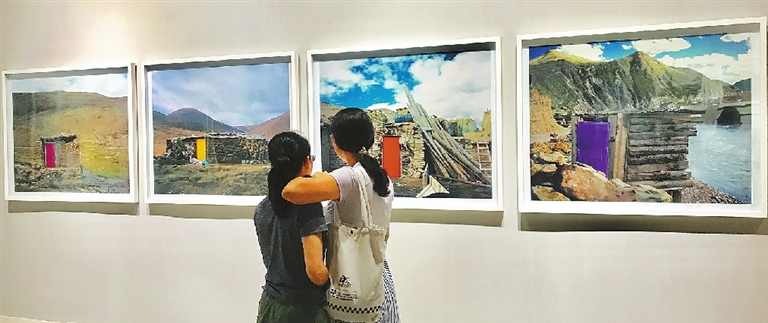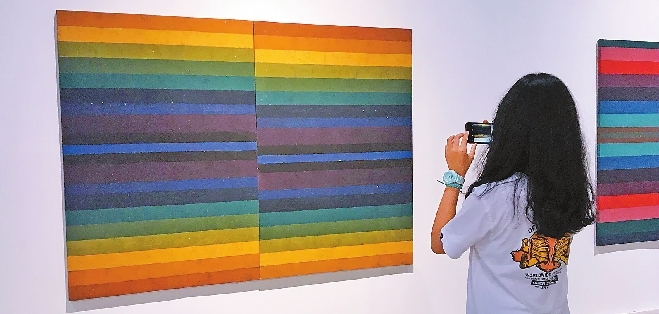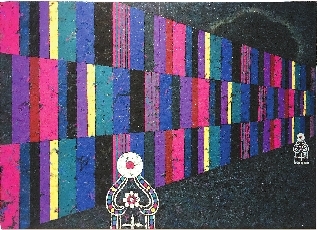



Cao Zhen caozhen0806@126.com CHINESE artist Xiong Wenyun, who is renowned for exploring color and its effects through painting, photography and land-art works, is holding a free exhibition at C2 Space in OCT-LOFT. Presented by OCAT Xi’an, the exhibition titled “A Thousand Rainbows” takes a retrospective look at the artist’s 40 years of creation. Xiong’s artworks are directly based on her life experiences. In the early 1970s, as a teenager, the Chongqing native was sent to live and labor in Wenchuan in the Aba Tibetan and Qiang Autonomous Prefecture in Sichuan Province, where she self-studied painting. She later recalled that it was the beautiful scenery, the winding mountains, the foggy villages and the simple villagers that gave her the strength to survive in the impoverished remote area, and which would draw her back to Tibet several times to create land-art works in the 1990s. In 1979, Xiong entered the Sichuan Fine Arts Institute in Chongqing and then the Central Academy of Fine Arts in Beijing to receive formal training in Chinese painting. At the Shenzhen exhibition, her light-toned realist paintings from the 1970s and 1980s portray the warm and lively lives of ordinary people. She also studied rock painting at the University of Tsukuba in Japan from 1987 to 1993. In her rock paintings, Tibetan women and decorations are her subjects, and the colors used became gradually darker as Xiong’s style changed from realism to abstract. Since 1996, abstraction has been dominant in Xiong’s artworks. Questions about painting techniques prompted her to abandon the use of concrete elements in her paintings. Color stripes and blocks from traditional Tibetan costumes inspired her and appeared in her abstract paintings, reflecting her emotions and mental state. Xiong believes that the patterns contained in Tibetan handwoven textiles have abstract implications. The nonrealistic color stripes and blocks have unique spiritual and symbolic significance. In the late 1990s, Xiong found that painting no longer gave her hope and confidence, and the techniques she acquired no longer helped her create new paintings. She began to free herself from painting and decided to do land art in Tibet, making colors “flow” in a broader space to express her thoughts. She completed seven harsh journeys to Tibet with incredible tenacity and willpower for her “The Flowing Rainbow” project from 1998 to 2001, painting rocks and tree logs for timber in Tibet with vibrant colors, and covering hut doors and trucks on the Sichuan-Tibet Highway with tarpaulins, also in highly saturated colors. The comprehensive project integrates multiple disciplines ranging from conceptual art and performance art to land art, adding exuberant hues to nature. The project was documented in photography and videos, which are part of the Shenzhen exhibition. Designed to advocate for environmental protection, the project expresses the artist’s concerns over tree-cutting in Tibet. She later stated that she saw nature as a haven for her spirit. She juxtaposes the vibrant splashes of color against Tibet’s stark mountain landscapes and expansive plateaus, showing the power of life. “At first, I had to persuade some drivers to cover their trucks with my colored tarpaulins, but later they were happy with my practice because the tarpaulins were waterproof, durable and beautiful,” said Xiong, who bore all of the expenses for the project herself in the beginning and later was funded by organizations and individuals. According to her, Tibetans see rainbows as gods’ ladders that bridge the earthly sphere with the celestial. “The exhibition’s title ‘A Thousand Rainbows’ is inspired from a way of nirvana in Tibetan Buddhism, which means that when an eminent monk dies, his body will be transformed into a rainbow and integrated into the dharma realm. Legend has it that people standing in the vicinity of a nirvana would see a rainbow in the sky, which they believe to be a miracle, and one that indicates a spiritual place,” curator Wang Mengmeng explained in the exhibition profile. Since 2001, Xiong has been engaged in art education for amateurs, creating the cartoon figure Kongkong, which then derived into handicrafts, story books and animations. She regarded this period as a return from the broad outside world to the inner life of herself. Color is still central to her imagination and a way to express her understanding of the universe. | 
